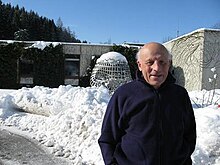Pierre Cartier (mathematician)
Pierre Emile Jean Cartier (born June 10, 1932 in Sedan , Ardennes ) is a French mathematician . His main interests are algebraic geometry , representation and category theory .
biography
Cartier grew up in the small town of Sedan in the Ardennes and went to school there and in Paris ( Lycée Saint-Louis ). He studied from 1950 at the École normal supérieure (ENS), where he initially wanted to study physics. Since the teaching was completely out of date, he switched to mathematics, which he heard from Laurent Schwartz and Henri Cartan . In 1951 he graduated ( Agrégé ) in mathematics and was invited to the summer Bourbaki Congress in the same year (in 1955 he officially became a member of Bourbaki, where he resigned in 1983 after reaching the age limit of 50). He was a CNRS scientist from 1954 to 1957and worked on his doctorate, which took place in 1958 with Henri Cartan ( Derivations et Deriveurs en Geometrie Algebrique ). From 1957 to 1959 he was at the Institute for Advanced Study . From 1961 he was a professor at the University of Strasbourg (then Faculté de Science). In 1971 he followed a call to the Institut des Hautes Études Scientifiques near Paris. At the same time he was from 1974 research director of the CNRS. In 1982 he became professor at the École polytechnique and in 1988 at the ENS.
Pierre Cartier introduced the Cartier operator and is the namesake of the Cartier divisor .
In 1970 he was invited speaker at the International Congress of Mathematicians in Nice ( Groupes formels, fonctions automorphes et fonction zeta des courbes elliptiques ). In 1978 he received the Prix Ampère from the French Academy of Sciences . He is a fellow of the American Mathematical Society .
In the Séminaire Nicolas Bourbaki he held by far the most lectures until 2002 (37).
Guy Henniart and Marc Rosso are among his PhD students .
He has been married since 1951 and has one daughter.
Fonts
- An introduction to Zeta Functions , in Michel Waldschmidt , Claude Itzykson , Jean-Marc Luck, Pierre Moussa (editor): Number Theory and Physics , Les Houches 1989, Springer 1992
- A mad day's work: from Grothendieck to Connes and Kontsevich. The evolution of concepts of space and symmetry , Bulletin AMS, Volume 38, 2001, pp. 389-408, online
- A primer on Hopf algebras , in Pierre Cartier u. a. Frontiers in Number Theory, Physics and Geometry , Volume 2, Springer Verlag 2007
-
Freedom in Mathematics , Springer India, 2016 (with Cedric Villani , Jean Dhombres, Gerhard Heinzmann), ISBN 978-81-322-2786-1 .
- Original French publication: Mathématiques en liberté , La Ville Brûle, Montreuil 2012, ISBN 978-23-601-2026-0 .
- Pierre Cartier: Grothendieck et les motifs. IHES 2000 preprint, online here: Pierre Cartier Prepublications.
- Pierre Cartier: Alexander Grothendieck. A country known only by name. Notices AMS, Volume 62, 2015, No. 4, p. 373, PDF.
- Pierre Cartier: A country of which one knows nothing except the name: Grothendieck and “Motive”. e-enterprise, 2016.
- Pierre Cartier, Cedric Villani, Jean Dhombres, Gerhard Heinzmann: Conversation sur les mathématiques , La ville brule 2012, Flammarion 2019
- Pierre Cartier, Cedric Villani, Jean Dhombres, Gerhard Heinzmann :: Freedom in Mathemaitcs , Springer India 2016
Awards
- 1979 Ampère Prize from the Académie des Sciences
Web links
- John J. O'Connor, Edmund F. Robertson : Pierre Cartier (mathematician). In: MacTutor History of Mathematics archive .
- IHES website with list of publications
- Cartier at the Mathematics Genealogy Project
- Javier Fresán The castle of groups , Interview Pierre Cartier, EMS Newsletter 2009, pdf
Individual evidence
- ↑ Interview with Cartier by M. Senechal The continuing silence of Bourbaki - an interview with Pierre Cartier , Mathematical Intelligencer, Volume 20, 1998, Issue 1, pp. 22-28. According to his memories, there was even a professor who denied the existence of atoms.
- ↑ In the successor to Jean Dieudonné, he was there, as secretary, the task of counter-reading the manuscripts before the final version
- ↑ Pierre Cartier in the Mathematics Genealogy Project (English)
| personal data | |
|---|---|
| SURNAME | Cartier, Pierre |
| ALTERNATIVE NAMES | Cartier, Pierre Emile Jean (full name) |
| BRIEF DESCRIPTION | French mathematician |
| DATE OF BIRTH | June 10, 1932 |
| PLACE OF BIRTH | Sedan (Ardennes) |
